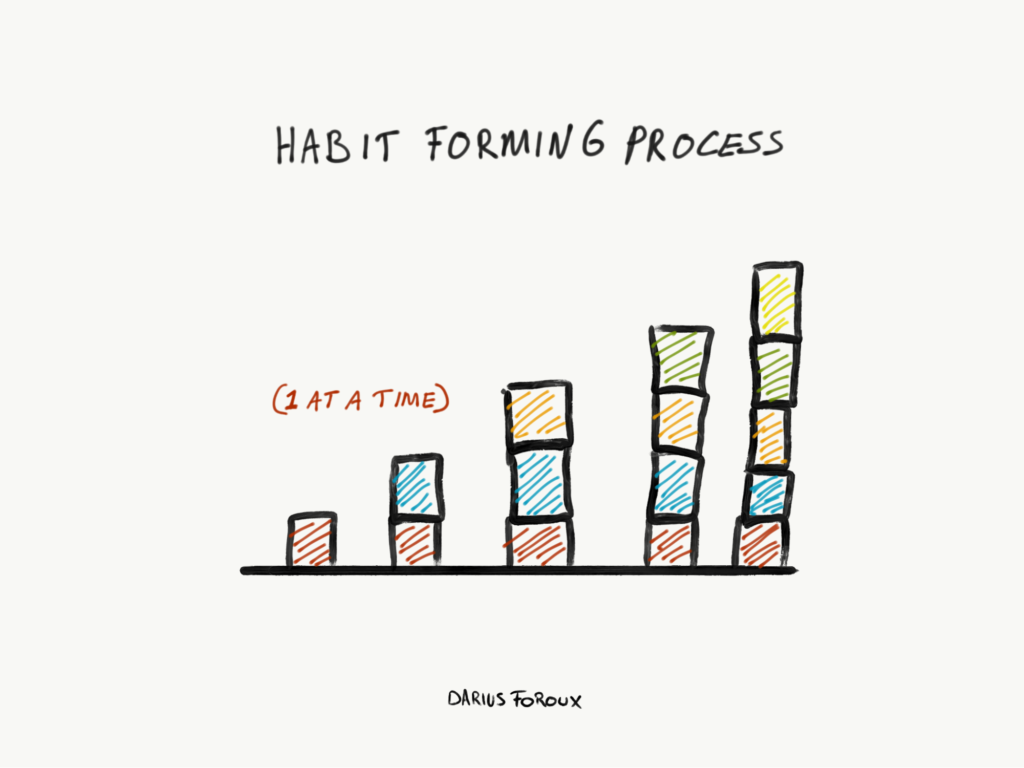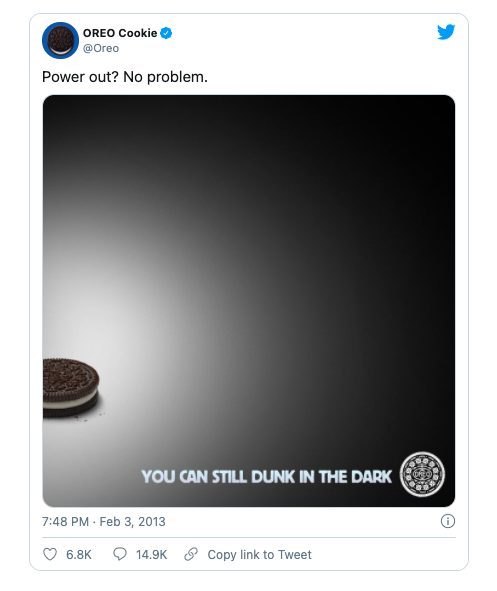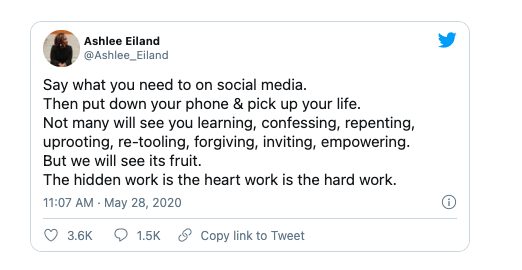You turn up the volume of your marketing efforts to meet quarterly KPIs—sending out more posts, emails, and ads. But instead of increasing leads, you see diminishing returns. What’s going on?
Customer-focused content marketing can help you stand out from the din of competitor marketing and connect with audiences. But knowing your marketing needs to be customer-focused is one thing; producing it is another.
This post will help you understand how customer-centric brands can build a content strategy that speaks directly about what users care about.
Table of contents
What is customer-centric content?
Customer-centric content is the type of content that is focused on your audience and built around your customer’s needs, addressing their problems, creating a positive experience for your users, and providing actual value for them.
How to create a customer-centric content strategy
Where do you start? Here are three steps to execute, not just hope for, a consistent customer-centric content marketing practice:
- Treat content marketing as a habit.
- Use research to speak to what your audience cares about.
- Deepen engagement with a unique brand voice.
1. Treat content marketing as a habit.
According to the Content Marketing Institute, only 9% of B2B marketers believe that their content strategy is effective. While the quality of content your company creates and distributes is important, most brands treat content marketing as a one-off campaign instead of an always-on effort.
Content marketing isn’t a tactic you use when you need to increase sales. Effective content marketing requires that you and your team put in consistent effort. How do you make it a habit?
Start small.
In his book Atomic Habits, James Clear talks about the importance of starting small. Most habits fail because people try to take on too much, too fast.
We’ve all been there. You come out of a marketing meeting with a list of a dozen things you want to do, only to be back at square one just a few weeks later.
To build momentum, begin with a small but manageable content marketing practice. Instead of committing to posting on your social media channels three times a day, start with a few times a week. Instead of committing to a dozen blog posts a month, aim for 2–3 high-quality posts a month.
Don’t overthink it. A blog post, for example, doesn’t have to be 5,000 words to offer value. Depending on the size of your team and marketing resources, choose a realistic path forward that you can hit every time.
Starting small gives you the opportunity to craft and optimize a documented content strategy, which puts you ahead of the 63% of businesses that don’t have one.
As you get more comfortable with your content marketing efforts, you can scale up as needed, aiming for more ambitious objectives over time. Taking a few content marketing initiatives from idea to shipped is far more effective than biting off more than you can chew.
Over time, the momentum you build from taking small steps can snowball.
Emphasize process over perfection.
One of the biggest challenges of content marketing, especially with large teams, is that a piece of content often has to pass through many hands for approval, which can slow down your progress.
Where possible, reduce the number of team members involved without undermining collaboration. Limit executive involvement to the approval of the overall strategy, and let your team take care of the rest.
You don’t need a team of 10 to make great content. Consider a modified pizza rule, championed by Jeff Bezos. Can your content team share a single pizza? If not, you may be setting up future roadblocks.
For most teams, three or four people is plenty:
- A designer to create visuals;
- A copywriter to draft the content;
- A content manager to oversee, edit, and approve the work.
The quicker you can get content out the door, the easier it is to discover patterns of what your customers like or dislike. An additional benefit of keeping your content team small is that you can often capitalize on time-sensitive trends.
In the “tweet heard around the world,” Oreo was able to quickly create a piece of content in real time that went viral and won numerous awards during the Super Bowl a few years ago. The tweet capitalized on the brief blackout during the Super Bowl while millions were watching.
If the content team at Oreo had to go through multiple revisions and approvals, they would have missed out on the opportunity.
Test over time.
A consistent flow of content marketing helps you identify:
- The best channels to reach and engage audiences;
- The best days and times to post;
- The types of content they prefer;
- The subjects they value most.
If, for example, you’re D2C and your products have visual appeal, Pinterest may be a good fit.
With clear goals in mind, you can use the data you collect to inform experimentation and drive decisions about future content creation (e.g., Does a post on LinkedIn generate more engagement than a post on Twitter?) Test visuals and messaging. See what people respond to and iterate.
Political campaigns are relentless when it comes to testing their content. They run different versions of the same ad to understand what performs better with target audiences, then tweak the creative based on what works best.
For a splash page used during Barack Obama’s first presidential campaign in 2008, staff tested all possible combinations of four buttons and six different media (three images and three videos).

The combination of button and media that performed best was different than the one campaign staff preferred (no surprise to anyone who runs a lot of experiments) and led to a 40.6% improvement in their sign-up rate and an additional $60 million in donations.
2. Use research to speak to what your audience cares about.
You’ve heard again and again how important it is to create content that focuses on issues important to your customers—and yet so few companies do it. Why?
The quantitative data you collect from marketing automation platforms and dashboards is important. It does not, however, give you insight on customer challenges and motivations—what you need to understand and connect with your audience. For that, you need to conduct qualitative research.
Research helps you create content marketing that speaks directly to what people care about. Without adequate insight into the needs, beliefs, and motivations of your audience, you risk developing content that gets scrolled past instead of consumed and acted on.
Here are six approaches to research that make it easier to develop user-centered content.
Read the room.
To quickly get a sense of what’s on your audience’s mind, scan social media. What conversations are happening? What content are people in your target audience sharing?
What are people most concerned about? Search relevant hashtags that customers might use on a regular basis. Spend time in popular forums or social networks where they spend most of their time.
For example, digital marketing pioneer Ann Handley recently came across a tweet reposted on Instagram. To Ann, the tweet resonated at a time when so many brands conveyed the same vanilla communications about the pandemic.
It inspired her to write in her e-newsletter about how to craft an authentic voice that moves people to action.
Even if you don’t have a sophisticated social listening tool, you can get a high-level feel for what people are most concerned about. Once you have a few data points, test your assumptions!
A little investment of time can give you a sense of what your brand can credibly and authentically weigh in on. We’ve all seen the “In these uncertain times” emails and black squares on social. The last thing you want to do is come off as insensitive or tone deaf.
Track industry trends.
Norbord, a manufacturer of wood-based panels, recognized that a shortage of house framers was hurting their clients and the U.S. economy. Building materials dealers and developers couldn’t meet the demand for new homes.
To address the framer shortage, Norbord launched “Thank a Framer,” a content marketing program to spotlight the crucial role of framers in the construction industry and to promote training programs to prepare more people to enter the profession.
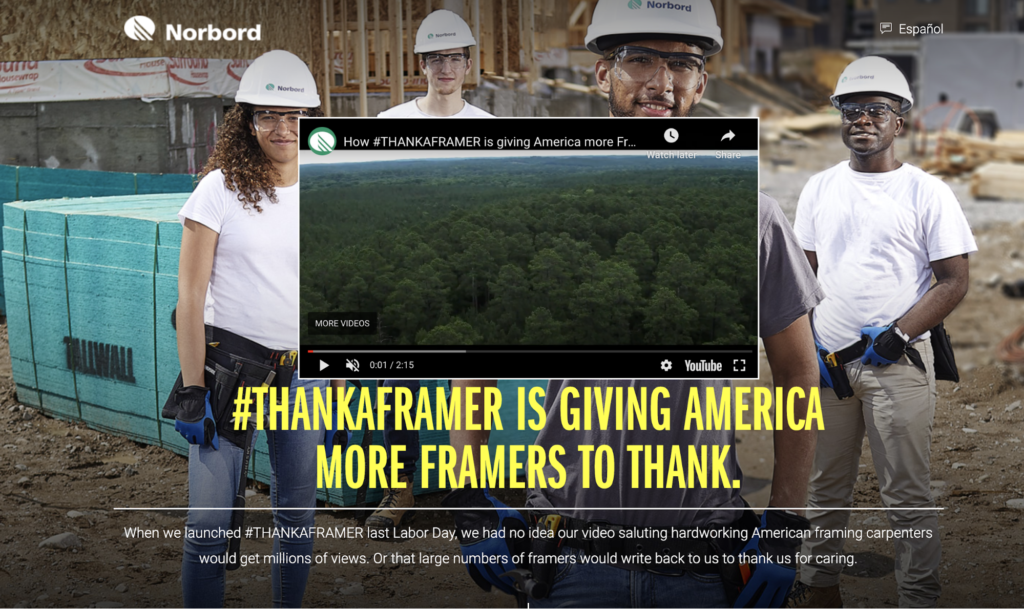
Their content program combined a microsite with videos, social posts, and a contest. An ad campaign amplified the message to professionals in the building trade. For a traditional industry not thought of as digitally engaged, the campaign exceeded their 1 million views target to capture 2.1 million views and reach 7.5 million in just four months.
Understand your audience’s behavior.
It is not easy to change people’s behavior, so why not meet your customers where they are?
Research can help you better understand your customers’ current behavior and where they spend their time:
- Demographic breakdown of users on social channels;
- Third-party research;
- Customer surveys.
The New York Public Library (NYPL) shows how even conventional, set-in-their-ways brands can respond to audience behavior. The more than 100-year-old NYPL wanted to attract a younger audience.
After learning that their target audience’s preferred social media platform was Instagram, they transformed their content to align with the native behavior on that channel. The result is Insta Novels:

Insta Novels transform classic novels like Alice’s Adventures in Wonderland, The Yellow Wallpaper, and The Metamorphosis into multimedia Instagram stories. The stories combine rich visuals with text across a series of Stories taps.
Although the stories disappear in 24 hours, they can continue to be accessed in the NYPL’s Highlights section.
Uncover how your audience makes decisions.
Customers have greater access to information than ever before. At first glance, this lack of control may seem like a loss of marketing opportunity, but it’s ready-made for content marketing.
The most effective way to collect information about the buying process and informational needs at each step is to ask customers directly. A short survey can work but interviews are even better.
To conduct an effective interview, ask open-ended questions about the buying process in your category. Use follow-up questions to understand why the person took the steps they did and why certain types of information were important at different stages.
Use the insights from your interviews to develop content that addresses the questions and concerns your target audience has at each point in their decision process, which is exactly what HubSpot does.
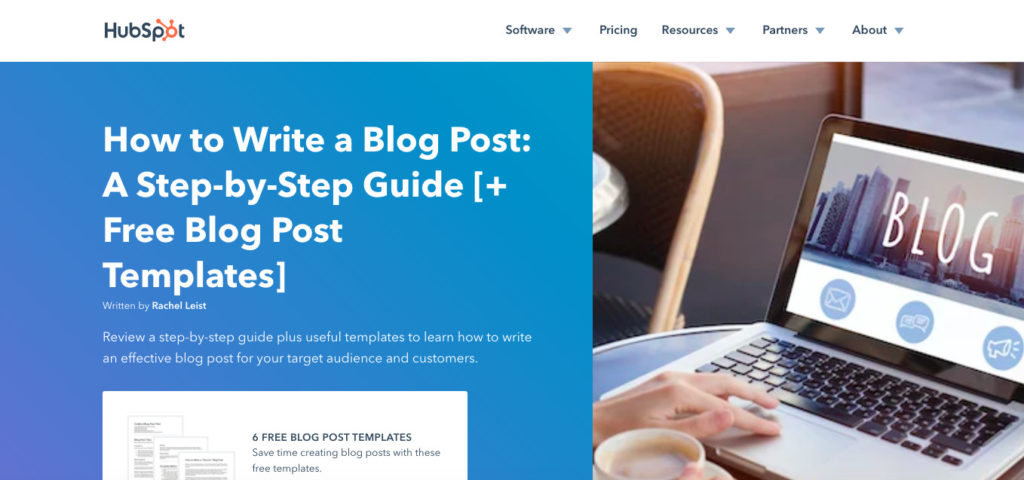
Hubspot is a content marketing machine, cranking out tools, checklists, blog posts, ebooks, videos and more—all focused on helping people answer their most pressing marketing questions.
Make research meaningful.
Research doesn’t only help you understand your audience; it can also be the content.
An asset management firm, OppenheimerFunds, used proprietary research on how emotions shape decision-making to educate potential clients on the power of optimism when considering long-term financial stability.
In place of numbing charts, graphs, and blocks of text, the firm offers a highly engaging and interactive experience that combines music, a quiz, illustration, and animation.
Collect stories.
You can go beyond developing content customers are interested in by featuring them in your content marketing. Instead of writing a dull whitepaper or impersonal case study that focuses on what you did, tell the stories of your customers.
Making customers the heroes of your case studies helps you demonstrate empathy and stand out from competitors—you’re speaking directly from your customers’ perspective.
Research can help you understand your category from your customers’ point of view and make it easier to identify the most compelling customer stories. (Your sales team is a great source for these stories.)
Barclays Bank uses video to make their customer and the community it serves the star of the story. One video revolves around a community’s passion for their local soccer club and the sponsorship of the team by a local small business, Low Cost Vans.
The video shows a Low Cost Vans representative sharing how meaningful the soccer team sponsorship is to their business. Music, shots of a game, and excited conversations with fans combine to create an emotionally moving tale.
3. Deepen engagement with a unique brand voice.
Your voice, tone, and brand personality can help personalize your message and make it stand out from the anonymous-feeling, bland corporate marketing that streams into people’s inboxes and other channels.
Here are four ways to translate your brand into personalized content marketing.
Empower your people.
User-generated content will far exceed branded content. Brands need to embrace this and accept they aren’t in complete control of their own brand.
Chris Brandt, CMO of Taco Bell Corp
The content people are creating and sharing online dwarfs the volume of content brands create. Moving forward, your target customers—your people—may be less and less interested in the content you produce.
Embrace it. Put the passion of your customers to work by empowering them to share their love of your brand.
Traditionally, corporations have used meticulously documented brand standards to control and manage their brand image. But companies never really control their brand.
Former presidential candidate Pete Buttigieg recognized this and made it easy for his supporters to advocate for and show off their passion for their candidate with an online brand toolkit.

The toolkit includes everything supporters need to show their love and spread the word—fonts, colors, logos, messaging, even personalized graphics for each state and a color pairing tool to take the guesswork out of color combinations for campaign logos. Buttigieg’s campaign made it easy for supporters to amplify their message.
Starbucks has created a similar online destination where fans can use interactive features to learn more about the elements of the Starbucks brand and how they work together.
Creative director Ben Nelson explained that the decision to open their brand to the public was “inspired by other brands being more transparent about their creative process.”

Instead of restricting use of your brand, find ways to make your brand accessible and empower your most passionate fans to advocate for you.
Develop a unique brand voice.
Most email newsletters are written in the same bland corporate monotone that make them easily forgettable.
The Hustle isn’t one of those. A tech and business news daily email, it uses a casual bro voice to target millennials.

The Hustle makes news fun, with pop culture references and punny headlines like “The call for change is coming from inside the house” (about employees pressuring their company to do more to promote racial equity) and “A new player in email knocked over a bushel of debate about Apple’s App Store” (about the new email service, Hey).
With over 1 million engaged email subscribers, they’re on to something.
Let’s take a look at another example, CBInsights, a market and business intelligence software platform. Their product isn’t cheap, which might lead you to expect their tone to be stodgy—that traditional finance and corporate speak.

And yet, they’re known for their funny subject lines and down-to-earth writing style:

Use your brand voice to offer a unique take on content that your audience can’t find anywhere else.
Embrace brand transparency.
You can also use content to reveal something about your brand.

Super U, a French supermarket chain, uses Snapchat to show that the fish they sell are only hours out of the water. The series, “Fresh Stories,” filmed with Snapchat Spectacles, takes shoppers through the fish’s journey from the fisherman to the sales manager and, finally, to the fish case at the grocery store.
Next to each fish is a label with a Snapcode that shoppers can scan to view the story. Because Snapchat Stories last only 24 hours, shoppers know that a fish was caught within the day.
Which parts of your business, if customers understood them better, might remove the fears or doubts that keep them from purchasing? Or showcase a differentiator that inspires loyalty?
Create an unforgettable brand experience.
When you hear the phrase “content marketing,” the first things to come to mind are probably assets like thought leadership pieces, blog posts, and newsletters, but don’t let convention limit your approach.

The Ace Hotel chain, known for its hip, boutique spaces, wastes no opportunity to use often overlooked touchpoints as an opportunity to create a brand experience.
From clothes hangers to blankets, ironing boards, trash cans, stair risers, and exit signs, The Ace covers surfaces with thoughtful and sometimes irreverent messages that personalize what can often be a lonely travel experience.
Whether it’s your packaging or PowerPoint templates, look for new opportunities for content marketing to deliver value to your audience.
Conclusion
Often, the biggest obstacles to creating customer-focused content marketing are clear, tangible steps to make execution straightforward.
But publishing consistently isn’t enough to stand out when you’re competing for attention, not just with other brands but with users’ own content.
Use research to understand consumers’ needs, motivations, and behaviors. Personalize your marketing with a distinctive brand voice to deepen engagement with your audience.
